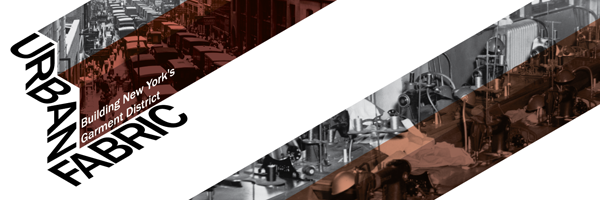The Skyscraper Museum is devoted to the study of high-rise building, past, present, and future. The Museum explores tall buildings as objects of design, products of technology, sites of construction, investments in real estate, and places of work and residence. This site will look better in a browser that supports web standards, but it is accessible to any browser or Internet device.
URBAN FABRIC: Building New York's Garment District
July 25, 2012 through February 17, 2013.
Click here to view the virtual exhibition!View curator Andrew Dolkart's lecture, "Developing the Garment District!"
The largest concentration of skyscraper factories in the world, the 18 blocks that were the heart of New York's Garment District, once supported more than 100,000 manufacturing jobs and produced nearly 3/4 of all women's and children's apparel in the United States. The rapid development of the district--the area of west midtown from 35th to 41st Streets and from Seventh to Ninth Avenues--occurred almost entirely within the boom decade of the 1920s, when more than 125 stepped-back "loft" buildings took the pyramidal forms dictated by the city's new zoning law.
Most of the high-rises were erected and owned by immigrant entrepreneurs who had begun their climb from clothing manufacturers, to builders, to real estate moguls. Some made and lost fortunes as boom turned to bust in the Depression, and their names--Lefcourt, Adler, Bricken, among others--have faded. A handful of little-known architects, all Jewish, like their clients, were responsible for nearly a hundred buildings within the district. Their work is highlighted in the exhibition.
"Seventh Avenue" means Fashion in the same way "Wall Street" means Finance. The architecture of the Garment District shaped the urban stage of Seventh Avenue. The high-rise lofts and showroom towers housed myriad small manufacturers and needle-trade workers-patternmakers, cutters, sewers, pressers, and finishers-as well as the executives, designers, and models for the leading labels. From these factories clothes were shipped to department stores across America or rolled on racks to Macy's or Gimbels an avenue east. Within the anonymous architectural infrastructure of zoned massing and speculative development, decades of enterprising creativity and human toil flowed out onto the streets of the city.
Urban Fabric is guest-curated by Andrew S. Dolkart, the Director of the Historic Preservation Program and the James Marston Fitch Associate Professor of Historic Preservation at the Columbia University Graduate School of Architecture, Planning and Preservation.
Major support for this exhibition was provided by the
LEON LEVY FOUNDATION
* * *
Urban Fabric is supported, in part, by public funds from the New York City Department of Cultural Affairs in partnership with the City Council.

Urban Fabric is supported, in part, by public funds from the New York State Council on the Arts with the support of Governor Andrew Cuomo and the New York State Legislature.



